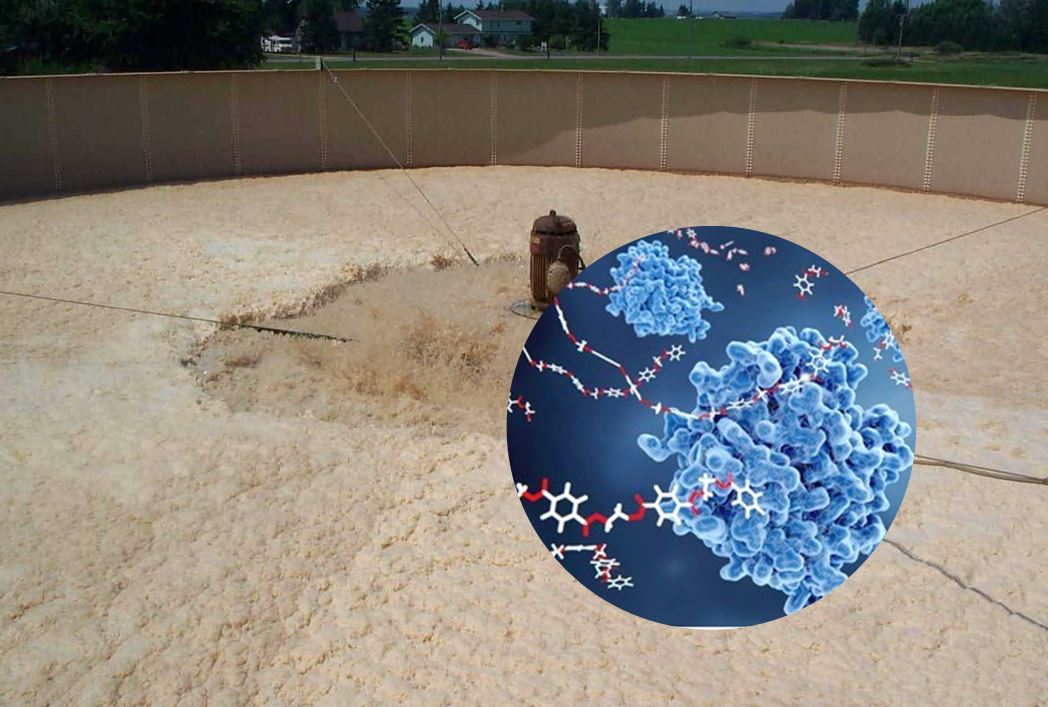Wastewater Treatment
Enzyme Catalysts
Engineered Enzymes for Wastewater Treatment
Enzyme Catalysts provide a non-hazardous and highly effective way to breakdown problematic compounds in wastewater.
From degrading fats and oils, to reducing sludge production, Parklink’s enzymes have been developed to provide targeted conversion of compounds in both aerobic and anaerobic environments.
Learn more about our range of enzymes available below.
SELECT-Protein®
SELECT-Protein®
Protein Degrading Biocatalyst
SELECT-Protein® is a biocatalyst that breaks down the complex proteins in dairy waste, meat packing, egg processing, and other waste with complex proteins. Proteins are the building blocks of biological life, and they can often be difficult or slow to digest in wastewater treatment. In the case of dairy waste, the protein is a milk solid called casein. Casein is a very complex and interwoven protein that takes a significant time for bacteria to break down. In order to begin the process, they require the catalyst that SELECT-Protein® provides.
Using SELECT-Protein® at the head of the plant improves a number of plant conditions. This product liberates the difficult-to-access proteins and converts them into nitrogen for your system, allowing reduced nitrogen supplementation. It will increase settling, lower sludge production, speed COD breakdown, reduce foaming, and lower COD while improving polymer function on the back end to decrease the presence of any odours. Since casein is a phosphoprotein, SELECT-Protein® will also improve phosphorous removal downstream.
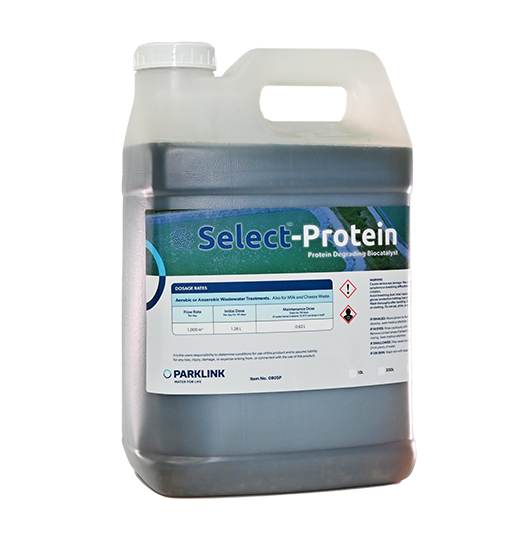
The Science Behind It
SELECT-Protein®: Essential in Dairy Waste
If you have a cheese plant with foaming or odours in the sludge storage tank, this is partly due to undigested casein. Bacteria can break down milk sugars easily, but milk solids, like the protein casein, are especially tough. Casein passing through will cause many issues in plants. SELECT-Protein® will quickly degrade and fix this, while also lowering COD levels and stopping odours.
SELECT-Protein® is great to apply to the head of the plant. This is a quick fix if you have 10# of food quickly passing through a 5# box. This product has saved at least one cheese plant from expanding its wastewater treatment plant.
A Revolutionary Product for All Protein Waste
Undigested protein waste is an issue with many sections of the food processing industry. SELECT-Protein® provides the tools bacteria need to digest any complex protein found in wastewater. Instead of turning into sludge in your storage tanks or lagoon, SELECT-Protein® turns this waste into fuel for your beneficial bacteria.
Applications
– Cheese Plants
– Dairy Plants
– Meat Packing Plants
– Breweries
– Rendering Facilities
Benefits
– Works quickly
– Breaks down casein
– Speeds up COD breakdown
– Reduce sludge
– Lowers COD
– Improves polymer function
– Decreases the presence of odours
– Improves phosphorous removal
Downloads
SELECT-Sludge®
SELECT-Sludge®
Biocatalyst Reduces Sludge and Undigested BOD
Thicker Sludge: Settles Better. Decants Clearer. Disposes Easier.
The catalysts in SELECT-Sludge® reduce sludge transport and disposal costs by digesting the toughest forms of undigested BOD. Lint, paper fibres, plant tissue, and oils typically settle out in a wastewater plant, then end up in the digester. Using SELECT-Sludge® prevents undigested BOD from bulking the sludge and impeding settling.
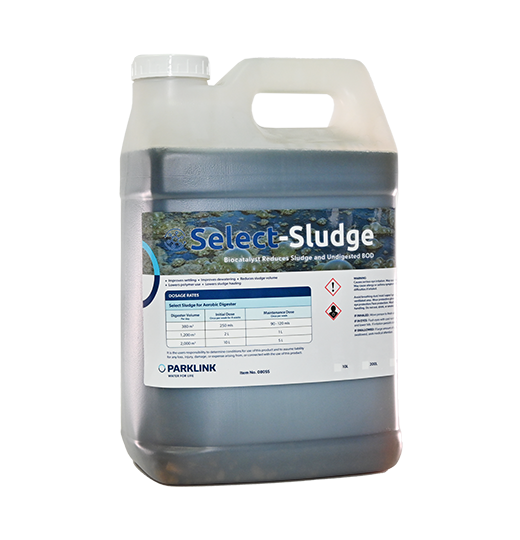
The Science Behind It
What can SELECT-Sludge® do for your digester?
The catalysts in SELECT-Sludge® convert insoluble BOD into soluble simple sugars and materials that the bacteria can more easily digest. This process promotes sludge reduction in aerobic digesters.
When this biochemical catalyst is added into a wastewater treatment plant, digestor or sludge storage tank it degrades the grease, oils, waxes and papers that the bacteria cannot. This liberates difficult-to-access carbon and turns it into food for the bacteria, creating less sludge.
This improves settling, creates a denser sludge and gives you much less to transport and dispose of.
If you think filaments are causing poor settling, contact the Parklink Laboratories for a microscopic analysis.
Benefits
– Improves settling
– Improves dewatering
– Reduces digester sludge volume
– Lowers polymer use
– Lowers sludge hauling
Downloads
SELECT-Starch®
SELECT-Starch®
For Complex Starches
SELECT-Starch® is a biocatalyst that will quickly break down high fructose corn syrup, corn starch, and other high molecular-weight polysaccarides into glucose for bacteria to quickly digest. This sugar wastewater degrader was designed to ease the wastewater process allowing major savings on treatment costs.
Degrades BOD related to:
– Corn syrup (including HFCS)
– Sugar waste
– Corn starch
– Vegetable starch
– Other polysaccharides
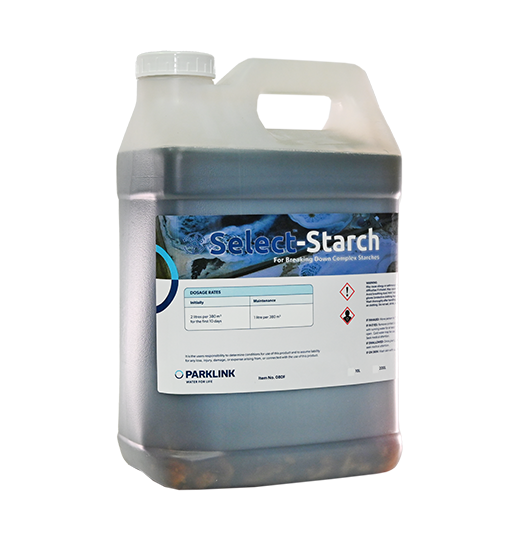
The Science Behind It
The Only Corn Syrup Degrader
Corn or Vegetable Processing (6) High Fructose Corn Syrup (HFCS), corn starch, and vegetable starch are among the most difficult complex carbohydrates to degrade in wastewater. These compounds are extremely high in BOD and their complexity resists bacterial breakdown.
Facilities with these constituents in their wastewater try to counteract the high COD by over-aerating. Over-aerating increases bad odours, costs thousands of dollars in electrical bills, and only provides a marginal reduction in COD.
A new biocatalyst to break down these complex, high molecular weight polysaccharides in wastewater processes. SELECT-Starch® speeds up the degradation of HFCS and vegetable starches while allowing major savings on aeration and other operational costs.
When used for HFCS: Qwik-Zyme CS allows complete breakdown of HFCS into glucose to be further digested by bacteria. Its high-performing biocatalyst is an essential piece missing from HFCS wastewaters.
When used for corn and vegetable starches: SELECT-Starch® is used to break down the complex starches into glucose and other bio-available simple sugars. Alternating between SELECT-Starch® and SELECT-Protien® when breaking down starches allows the bacteria to access even more of the simple sugars and degrade them.
Benefits:
– Fast degradation of High Fructose Corn Syrup
– Aids Bacterial Digestion
– Reduces Odours
– Reduces Aeration Expenses
– Reduces Sludge Production
– Improves Dissolved Oxygen
Downloads
SELECT-Grease®
SELECT-Grease®
Grease Degrader
SELECT-Grease® is a ‘grease degrader’ that incorporates three types of fat-degrading biocatalysts to provide dramatic hydrolysis of fat, oil, and grease (FOG). These catalysts speed the breakdown of complex fat molecules into simple short chain fatty acids. This is not a bacterial product. SELECT-Grease® will convert the FOG into more easily-assimilated material for the bacteria.
SELECT-Grease® can degrade a range of fatty acids such as oleic, steric, palmitic as well as fish oils, triglycerides, milk, and animal fats. SELECT-Grease® is often used in conjunction with Select-Defoam-bac® to control foaming and bulking issues.
SELECT-Grease® is an excellent product for grease control in sequencing batch reactors (SBR), wastewater treatment plants, equalisation tanks and food processing plants.

The Science Behind It
Why is it so important to control fats, oils and grease?
In the winter months, when water temperatures are colder, the naturally occurring bacteria cannot completely break down FOG and the fatty acids that build up in the wastewater plant. These fatty acids are then taken up by filaments like Microthrix Parvicella and Nocardia which allows them to float and foam. SELECT-Grease® breaks up these fatty acids and cuts off the filament’s food source.
SELECT-Grease® works well with Select-Defoam-bac® and is used in all types of municipal and industrial applications. Select-Defoam-bac® alters the bacteria populations so the foam will not return while SELECT-Grease® helps to get the grease under control.
This product is either metered or poured into the front end of the wastewater process.

Applications
- Wastewater networks and pump stations
- Sequencing Batch Reactors (SBRs)
- Municipal Wastewater Treatment Plants
- Food Processing Plants
Benifits
- Reacts quickly
- Degrades fat, oil, and grease (FOG)
- Prevents foaming
- Cleans plants
- Easy to use
Case Studies
Manufacturer of Luxury Soaps Controls Fatty Acid Foaming
Challenge
High Lauric and Stearic Fatty Acids
Solution
SELECT-Grease®, SELECT-Surfactant®
Results
An organic chemical manufacturer contacted us about foam being generated in their treatment system. They use a series of two lagoons, with high aeration in the first lagoon to pretreat their waste stream before sending it to the municipal wastewater treatment plant. The waste stream has high concentrations of lauric and stearic acids which contribute to influent BOD 600 ppm, and COD 200 ppm. The system was not achieving complete breakdown of these fatty acids as the waste stream moved quickly through the system. The operator began using SELECT-Surfactant® to add new bacteria cultures which break-down of fatty acids. This improvement was enough to make the customer happy, but we thought that adding our SELECT-Grease®, liquid biocatalyst product, would help break down the fatty acids even more quickly. The biocatalyst accelerated the process, a huge benefit in this waste stream with a short detention time. The combination of biocatalyst and bacteria brought the systems effluent waste stream down to BOD 8.1 ppm, and COD 0.4 ppm.

Municipal WWTP and Local Industry
System
Activated Sludge
Flow Rate
550 m³ per day
Background
The municipality upgraded their wastewater plant three years ago with fine bubble aeration. Immediately they began noticing a foot of foam on the basins and persistently higher effluent ammonia numbers. They traced the foaming issue down to a tannery in town. The tannery has an existing wastewater process of their own consisting of an equalization tank followed by aeration and a very simple DAF unit. To clean the fat, oil and grease off hides the tannery uses surfactants, substances similar to soap in their make-up. We learned the cause of the issue in the municipal plant was that surfactants were passing through the tannery system undigested, and then foaming when they hit the fine bubble diffusers at the municipal system. The tannery experimented with a number of surfactants to help stop the foaming, but to no avail.
Solution
The solution was to breakdown the surfactants at the tannery’s treatment plant. We had them increase the holding time in their EQ tank to create anoxic conditions and then they added SELECT-Grease® and SELECT-Protein® to speed the breakdown the grease and long chain fatty acids. The process was further enhanced by adding SELECT-Defoam-bac® to the aeration tank. SELECT-Defoam-bac® micronutrient blend boosts the ability of native bacteria to degrade fatty acids and grease. The biocatalysts kicked off the surfactant degradation process and native bacteria with the help of SELECT-Defoam-bac® finished the process. Immediately, the plant noticed 95% less foam and better settling. As the foam went away they also realised that the surfactants had been knocking out their nitrifiers. As the surfactants were no longer hitting them as they had before, nitrification improved and their effluent ammonia dropped. Now both the municipality and tannery are happy.
Sequencing batch reactor (SBR)
Challenge
A customer in has a SBR system that was having an ongoing issue with Microthrix Parvicella. It was causing bad foaming, poor settling, and a cloudy effluent. This plant was out of compliance and needed immediate help. Their flow rate was 450 m³ / day.
Solution
They added the required dose of SELECT-Defoam-bac® and SELECT-Grease® each day for 7 days.
Results
7 days later: Grease was cut in half and settling had improved. 21 days later: The foam was gone and the plant was in compliance with their very stringent limits.
Food Processor

System
Trickling Filter>DAF> Aeration Basin
Flow Rate
900 m³ per day
Challenge
Malfunctioning DAF-caused foaming in Aeration
Background
To achieve their effluent goals, this processor has to incorporate 2 pretreatment steps before the waste stream gets to their aeration basin. First a trickling filter takes the BOD from around 4000 ppm to 1000 ppm. Next a Dissolved Air Floatation (DAF) unit removes all the grease that the trickling filter didn’t remove. Trickling filters are notorious for allowing grease to pass right through them. They system generally worked pretty well but was dependent on the DAF making up for the shortcomings of the trickling filter. However, one day a mechanical issue resulted in the DAF being taken offline, and the timeline for getting the replacement part was unknown. With only the trickling filter for pretreatment, and no other way to remove the fats, oils, and grease (FOG) they soon began foaming.
Solution
This customer started with our fatty acids analysis to determine what the concentrations of FOG were, and which fatty acids it consisted of.
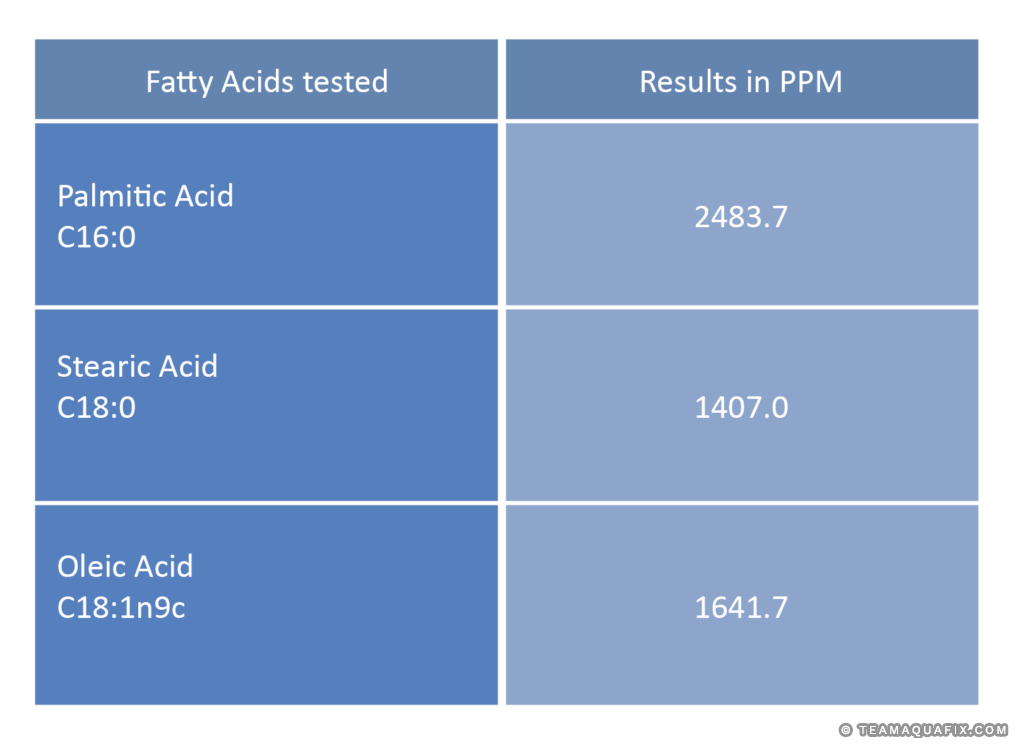
Fatty Acid Testing revealed especially high amounts of Palmitic, Stearic, and Oleic acid. Also typically the highest concentration Fatty Acids in municipal influent.
Since the loss of the DAF, total fatty acids in aeration had now jumped up to 7551.5 ppm. The fastest way to reduce the foam was to accelerate the degradation of the very high FOG in the basin. The most prevalent long chain fatty acids are also typically slow to degrade molecules in an aerobic system. The operator used SELECT-Grease™ at the prescribed dose rate each day, combined with our SELECT-Defoam-bac® blend. The biocatalysts in SELECT-Grease® act on specific structures in the FOG, which allows bacteria in the system to quickly degrade the FOG molecule. Within 30 days the foam had disappeared, despite the DAF unit still not being brought back online.
Downloads
SHIELD-Degrease®
SHIELD-Degrease®
Grease Removal
SHIELD-Degrease® is a revolutionary new grease-digesting bacteria complex for wastewater networks and pump stations. It softens and removes grease, degrades grease on the walls, and lowers hydrogen sulfide.
SHIELD-Degrease® combines hydrophilic bacterial cultures with a fast acting biocatalyst that quickly breaks up and digests grease in pump stations where it has hardened on the walls.
SHIELD-Degrease® can be used successfully in conjunction with SHIELD-Maintainer™ in wastewater networks but is also an excellent solution on its own for grease traps and drains.

The Science Behind It
Degrade It, Don’t Push It!
Most grease removal products are citric-based oil-separators that just push along the grease or don’t work at all. If pushed, the harmful materials go right to the wastewater treatment plant which can cause major upsets and foaming. SHIELD-Degrease® will degrade and digest heavy buildup of fats, oils and grease stuck on the walls of pump stations and pipelines, leaving the wastewater free of incoming grease.
Flushable Wipes Clogging Lift Stations
Operators are fighting against the issues caused by “flushable” wipes all over the country. While marketed as biodegradable, the majority of these wipes are made from polyester, a material that generally takes 20 to 40 years to break down. Parklink has seen firsthand the clogs and compaction these wipes cause, binding together with grease and other matter in sewer lines and lift stations. The wipes really begin to cause problems when combined with grease to form mats and float, clogging lift stations. SHIELD-Degrease® dramatically hydrolyzes grease to rob flushable wipes of the glue they need to form large clumps and keep operations running smoothly.
Applications
- Pump Stations
- Wet Wells
- Drain Lines
- Sewer Lines
- Grease Traps
Applications
- Pump Stations
- Wet Wells
- Drain Lines
- Sewer Lines
- Grease Traps
Benefits
- Degrades and breaks down grease
- Safe and easy to apply
- Fast-acting formula
- Contains no petroleum solvents
- Great Results
- Non-Flammable
- Gentle on cords and floats
- Works well for holiday peak flows
Downloads
ANAGEN-Degrease®
ANAGEN-Degrease®
Biocatalyst for anaerobic breakdown of FOG
ANAGEN-Degrease® – Biocatalyst for anaerobic breakdown of FOG
ANAGEN-Degrease® is formulated to provide immediate reduction of fat, oil, and grease in anaerobic digesters and lagoons to avoid issues with grease caps and foaming. The biocatalysts in ANAGEN-Degrease® rapidly speed the breakdown of complex fat molecules into simple short-chain fatty acids which then break down to acetic acid, a compound used in methanogenesis.
The goal of this product is to limit volatile acid accumulation, while also increasing biogas generation, and improving volatile solids destruction.
ANAGEN-Degrease® can degrade a range of fatty acids such as linolenic, oleic, stearic, and palmitic as well as fish oils, triglycerides, dairy, and egg fat. The production of short-chain fatty acids is very important as part of the acidogenesis–methanogenesis process.

Applications and Benefits
Anaerobic digesters/lagoons for:
- Dairy processing
- Meat processing
- High-fat food processing
Ana-Zyme G Benefits:
- Eliminates grease caps
- Avoid foaming due to fats, oils and greases
- Prevents the buildup of fatty acids
- Improves VA: ALK Ratio
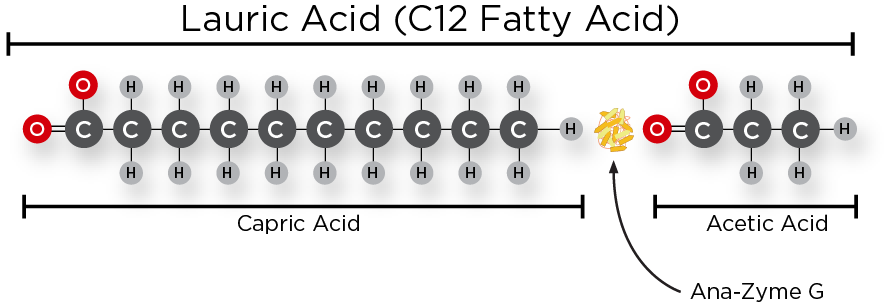
The diagram to the left represents how ANAGEN-Degrease™ completes the β-Oxidation of Lauric Acid (a saturated fatty acid) into Capric Acid and Acetic Acid. All fatty acids are eventually converted 2 carbons at a time into acetic acid, which is the ideal food for methanogens. Therefore, fats—if degraded properly—can be an excellent food substrate in anaerobic systems.
High Levels of Grease In Anaerobic Digesters
FOG must undergo several steps to be converted into acetate, the ideal food substrate for methanogens: disintegration, hydrolysis, and β-oxidation.
Limitations in the rates of any of these steps can lead to uneven degradation of FOG, which results in variable volatile acid loading on methanogens. Variable loading of volatile acids can easily overwhelm methanogens leading to accumulation of volatile acids, eventually resulting in a drop in digester pH. These impacts are exacerbated in systems with high FOG loading.
However, FOG can be made into an excellent food substrate for anaerobic digestion, due to their high COD content, as well as their high potential to generate large quantities of acetate or acetic acid. It just needs a little processing to get there.
ANAGEN-Degrease™ and Anaerobic Grease
ANAGEN-Degrease™ acts as a catalyst to naturally occurring bacteria to aid in the breakdown of FOG, which prevents the overloading of methanogens and frees up this new food source. ANAGEN-Degrease™ does this by targeting triglycerides and long-chain fatty acids to convert them evenly into short-chain fatty acids. This stabilization of fatty acid degradation allows methanogens to better acclimate to fatty acid loading. They are then able quickly uptake these fatty acids, reducing the chances of volatile fatty acid accumulation. In addition, ANAGEN-Degrease™ prevents the accumulation of undegraded fats in a system, which enhances volatile solids destruction, particularly in systems with limited mixing such as lagoons
Downloads
ANAGEN-Protein®
ANAGEN-Protein®
Biocatalyst That Speeds Digestion of Proteins in Anaerobic Digesters
ANAGEN-Protein® is a biocatalyst specifically formulated to quickly and thoroughly degrade complex proteins commonly found in the anaerobic waste of meatpacking, rendering, food processing, or farming facilities.
Proteinaceous materials are among the most difficult substrates for anaerobic digesters to break down, due to their high nitrogen concentration. They often hinder anaerobic digester performance by passing through the process before they can be completely degraded. ANAGEN-Protein® bridges the gap between the considerable potential of anaerobic digesters and difficult proteins by breaking them down in a way that methanogens cannot. The rapid hydrolysis of these complex proteins into soluble amino acids creates food and an environment more favourable for methanogenic bacteria.
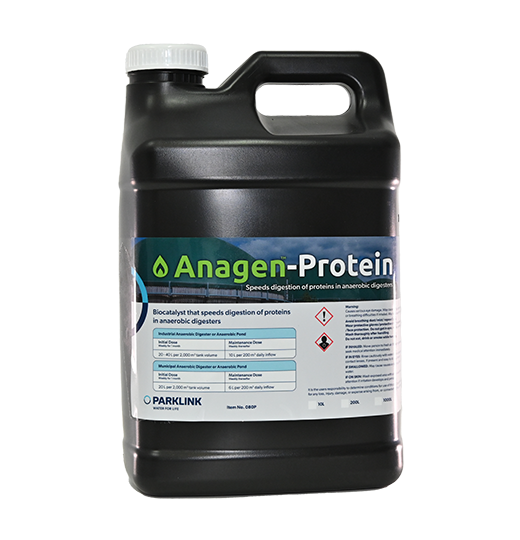
Applications and Benefits
ANAGEN-Protein® Applications
Anaerobic digesters/lagoons for:
– Dairy processing
– Meat processing
ANAGEN-Protein® Benefits
– Improves anaerobic enzyme production
– Improves volatile solids destruction
– Improves methane production
– Releases amino acids from complex proteins
The Difficulty of Degrading Proteins Anaerobically
Anaerobic bacteria tend to be poorly specialized for the degradation of protein. Carbohydrates usually make better feed substrates than protein due to their high cBOD content and the low nitrogen requirements of anaerobic bacteria. Fat, oil, and grease—while usually undesirable in a digester—also have a high cBOD content. This means that anaerobic hydrolysis favours the degradation of fats and complex sugars, over the degradation of proteins. However, when broken down, protein provides valuable amino acids which improve the production of naturally occurring anaerobic enzymes. When free amino acids are absent, anaerobic bacteria need to produce them using simple carbon substrates and ammonia, a process that takes additional metabolic steps and wastes carbon, making the process inefficient.
ANAGEN-Protein® improves anaerobic efficiency by outsourcing that extra metabolic step in the degradation of proteins so the anaerobic bacteria can focus their resources on breaking down carbon substrates and producing methane. This leads to improved methane generation, lowers effluent COD, and improved volatile solids destruction.

